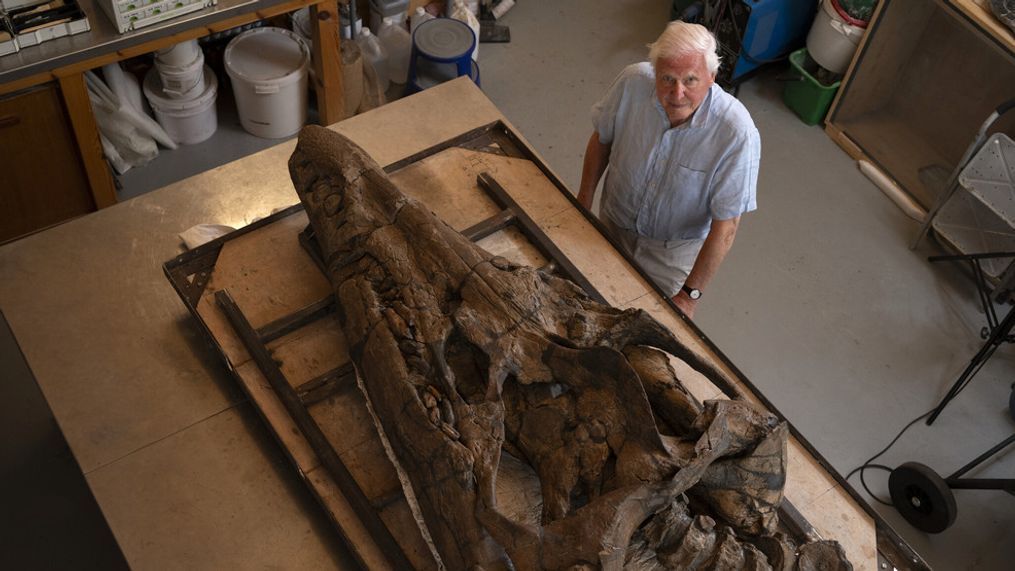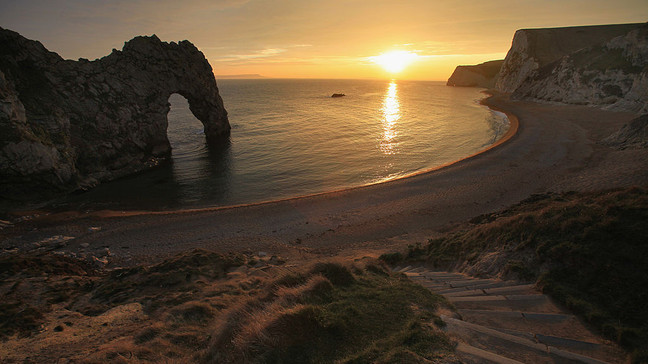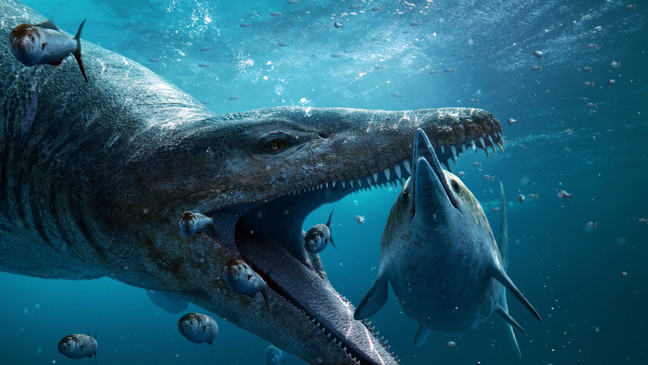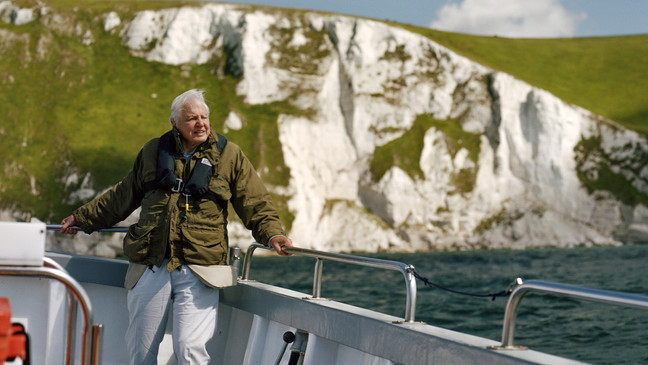Giant skull of prehistoric sea monster found preserved on England's Jurassic Coast
WASHINGTON (TND) — The largely intact skull of a prehistoric sea monster has been unearthed by scientists on England's Jurassic Coast.
It belongs to a pliosaur, which was a "ferocious marine reptile" that lived in the oceans about 150 million years ago, according toBBCNews.
Scientists report the skull measures 6 feet and has 130 teeth that could kill in a single bite.
Dr. Andre Rowe from Bristol University told the BBC he has "no doubt it was sort of like an underwater T-rex."
"The animal would have been so massive that I think it would have been able to prey effectively on anything that was unfortunate enough to be in its space," he said.
{sd-embed class="sd-embedded-media" data-embed-file="%3Ciframe%20src=%22https://www.facebook.com/plugins/post.php?href=https%253A%252F%252Fwww.facebook.com%252Ftheetchescollectionkimmeridge%252Fposts%252Fpfbid0VEYk7dM1J1PZpWwrbVgi8Um1j9CdG157WcBCh4mzmj3mtHEt9CdfoHzuPsrUCfiEl&show_text=true&width=500%22%20width=%22500%22%20height=%22701%22%20style=%22border:none;overflow:hidden%22%20scrolling=%22no%22%20frameborder=%220%22%20allowfullscreen=%22true%22%20allow=%22autoplay;%20clipboard-write;%20encrypted-media;%20picture-in-picture;%20web-share%22%3E%3C/iframe%3E" data-embed-type="facebook" contenteditable="false"}{/sd-embed}
The skull was first spotted by Paleontologist Steve Etches' friend, Phil Jacobs when he saw the snout during a walk on the beach of Kimmeridge Bay in Dorset.
Scientists spent months digging the fossil out of the cliffside and cleaning it up.
Etches said it is one of the best fossils he has ever worked on.
"The lower jaw and the upper skull are meshed together, as they would be in life. Worldwide, there's hardly any specimens ever found to that level of detail," he said. "And if they are, a lot of the bits are missing, whereas this, although it's slightly distorted - it's got every bone present."
{sd-embed class="sd-embedded-media" data-alt="Attenborough%20and%20the%20Jurassic%20Sea%20Monster_01ssic%20Sea%20Monster_00_020.jpg" data-caption="Pliosaur%20(giant%20sea%20monster)%20%20about%20to%20attack%20ichthyosaur%20in%20ocean,%20with%20jaws%20open,%20with%20small%20fish%20swimming%20close%20by%20(Credit:%20BBC%20Studios)%7B%7D" data-duration="" data-externalid="5ec7f21f-e8eb-45a7-8c7d-2f62e6782d82" data-mediatype="image" data-renditions="%7B%22large16x9%22:%7B%22blurSigma%22:-1,%22height%22:1152,%22label%22:%22large16x9%22,%22scaleWidth%22:986,%22url%22:%22/resources/media/5ec7f21f-e8eb-45a7-8c7d-2f62e6782d82-large16x9_AttenboroughandtheJurassicSeaMonster_01ssicSeaMonster_00_020.jpg%22,%22width%22:2048,%22x%22:0,%22y%22:0,%22uuid%22:null,%22id%22:%22c369a655-b08e-4506-9dbb-e258931a0e67%22,%22preciseWidth%22:null,%22preciseHeight%22:null,%22name%22:%22large16x9Url%22,%22rendition%22:%22large16x9%22,%22labelOrConvertedName%22:%22large16x9%22%7D,%22jumbo16x9%22:%7B%22blurSigma%22:-1,%22height%22:1152,%22label%22:%22jumbo16x9%22,%22scaleWidth%22:1320,%22url%22:%22/resources/media/5ec7f21f-e8eb-45a7-8c7d-2f62e6782d82-jumbo16x9_AttenboroughandtheJurassicSeaMonster_01ssicSeaMonster_00_020.jpg%22,%22width%22:2048,%22x%22:0,%22y%22:0,%22uuid%22:null,%22id%22:%2222119725-cf19-4625-84b1-463a3f230ad1%22,%22preciseWidth%22:null,%22preciseHeight%22:null,%22name%22:%22jumbo16x9Url%22,%22rendition%22:%22jumbo16x9%22,%22labelOrConvertedName%22:%22jumbo16x9%22%7D,%22small16x9%22:%7B%22blurSigma%22:-1,%22height%22:1152,%22label%22:%22small16x9%22,%22scaleWidth%22:160,%22url%22:%22/resources/media/5ec7f21f-e8eb-45a7-8c7d-2f62e6782d82-small16x9_AttenboroughandtheJurassicSeaMonster_01ssicSeaMonster_00_020.jpg%22,%22width%22:2048,%22x%22:0,%22y%22:0,%22uuid%22:null,%22id%22:%2206e48fb3-a4af-4d62-8b8b-c890a831ae65%22,%22preciseWidth%22:null,%22preciseHeight%22:null,%22name%22:%22small16x9Url%22,%22rendition%22:%22small16x9%22,%22labelOrConvertedName%22:%22small16x9%22%7D,%22full16x9%22:%7B%22blurSigma%22:-1,%22height%22:1152,%22label%22:%22full16x9%22,%22scaleWidth%22:2048,%22url%22:%22/resources/media/5ec7f21f-e8eb-45a7-8c7d-2f62e6782d82-full16x9_AttenboroughandtheJurassicSeaMonster_01ssicSeaMonster_00_020.jpg%22,%22width%22:2048,%22x%22:0,%22y%22:0,%22uuid%22:null,%22id%22:%228201d459-3f4f-4a54-8e56-247388a04e9b%22,%22preciseWidth%22:null,%22preciseHeight%22:null,%22name%22:%22full16x9Url%22,%22rendition%22:%22full16x9%22,%22labelOrConvertedName%22:%22full16x9%22%7D,%22medium16x9%22:%7B%22blurSigma%22:-1,%22height%22:1152,%22label%22:%22medium16x9%22,%22scaleWidth%22:648,%22url%22:%22/resources/media/5ec7f21f-e8eb-45a7-8c7d-2f62e6782d82-medium16x9_AttenboroughandtheJurassicSeaMonster_01ssicSeaMonster_00_020.jpg%22,%22width%22:2048,%22x%22:0,%22y%22:0,%22uuid%22:null,%22id%22:%227aac2230-670d-4b3d-8f7d-1036f537aace%22,%22preciseWidth%22:null,%22preciseHeight%22:null,%22name%22:%22medium16x9Url%22,%22rendition%22:%22medium16x9%22,%22labelOrConvertedName%22:%22medium16x9%22%7D%7D" data-thumburl="/resources/media/5ec7f21f-e8eb-45a7-8c7d-2f62e6782d82-medium16x9_AttenboroughandtheJurassicSeaMonster_01ssicSeaMonster_00_020.jpg" data-title="Giant%20skull%20of%20prehistoric%20sea%20monster%20found%20preserved%20on%20England's%20Jurassic%20Coast" data-url="" data-defaultthumb="true" data-embed-file="%0A%20%20%20%20%3Cdiv%20class=%22sda-ImageEmbed%22%3E%0A%20%20%20%20%20%20%20%20%3Cimg%20src=%22/resources/media/5ec7f21f-e8eb-45a7-8c7d-2f62e6782d82-medium16x9_AttenboroughandtheJurassicSeaMonster_01ssicSeaMonster_00_020.jpg%22%20alt=%22%22%20/%3E%0A%20%20%20%20%20%20%20%20%3Cdiv%20class=%22sda-ImageEmbed-caption%22%3EPliosaur%20(giant%20sea%20monster)%20%20about%20to%20attack%20ichthyosaur%20in%20ocean,%20with%20jaws%20open,%20with%20small%20fish%20swimming%20close%20by%20(Credit:%20BBC%20Studios)%3C/div%3E%0A%20%20%20%20%3C/div%3E" data-embed-type="image" contenteditable="false"}{/sd-embed}
In a video from Etches' museum, the pliosaur may have had a bite force of nearly 50,000 newtons -- enough to bite through a car.
According to BBC, the snout is dotted with small pits that may have been where glands helped it detect changes in water pressure by prospective prey and a hold on its head suggests it may have had a third eye to help in locating other animals.
The skull will be displayed in Etches' museum in Kimmeridge next year.
{sd-embed class="sd-embedded-media" data-embed-file="https://www.youtube.com/embed/Z0eNUv5h12g?si=TgqvGm0EwKU6WzAh" data-embed-type="youtube" contenteditable="false"}{/sd-embed}
But for now, he believes the rest of the fossil is just waiting to be found in the cliffs.
"I stake my life the rest of the animal is there," Etches told BBC News. "And it won't be very long before the rest of the pliosaur drops out and gets lost. It's a once-in-a-lifetime opportunity."
The team's discovery will be featured on New Year's Day in the BBC documentary "Attenborough and the Jurassic Sea Monster" withDavid Attenborough and will air on PBS in February.




